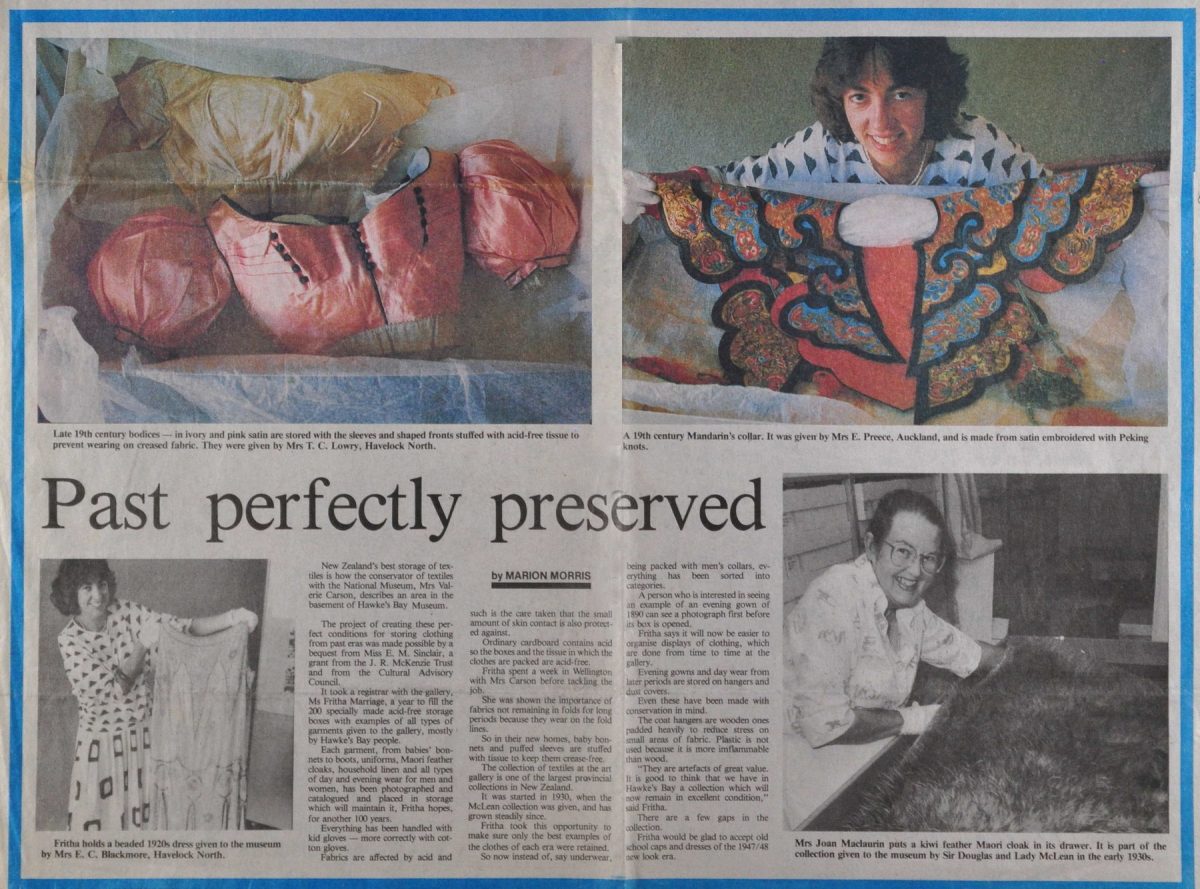Past perfectly preserved
by MARION MORRIS
New Zealand’s best storage of textiles is how the conservator of textiles with the National Museum, Mrs Valerie Carson, describes an area in the basement of Hawke’s Bay Museum.
The project of creating these perfect conditions for storing clothing from past eras was made possible by a bequest from Miss E.M. Sinclair, a grant from the J.R. McKenzie Trust and from the Cultural Advisory Council.
It took a registrar with the gallery, Ms Fritha Marriage, a year to fill the 200 specially made acid-free storage boxes with examples of all types of garments given to the gallery, mostly by Hawke’s Bay people.
Each garment, from babies’ bonnets to boots, uniforms, Maori feather cloaks, household linen and all types of day and evening wear for men and women, has been photographed and catalogued and placed in storage which will maintain it, Fritha hopes, for another 100 years.
Everything has been handled with kid gloves – more correctly – with cotton gloves.
Fabrics are affected by acid and such is the care taken that the small amount of skin contact is also protected against.
Ordinary cardboard contains acid so the boxes and the tissue in which the clothes are packed are acid-free.
Fritha spent a week in Wellington with Mrs Carson before tackling the job.
She was shown the importance of fabrics not remaining in folds for long periods because they wear on the fold lines.
So in their new homes, baby bonnets and puffed sleeves are stuffed with tissue to keep them crease-free.
The collection of textiles at the art gallery is one of the largest provincial collections in New Zealand.
It was started in 1930, when the McLean collection was given, and has grown steadily since.
Fritha took this opportunity to make sure only the best examples of the clothes of each era were retained.
So now instead of, say underwear, being packed with men’s collars, everything has been sorted into categories.
A person who is interested in seeing an example of an evening gown of 1890 can see a photograph first before its box is opened.
Fritha says it will now be easier to organise displays of clothing, which are done from time to time at the gallery.
Evening gowns and day wear from later periods are stored on hangers and dust covers.
Even these have been made with conservation in mind.
The coat hangers are wooden ones padded heavily to reduce stress on small areas of fabric. Plastic is not used because it is more imflammable than wood.
“They are artefacts of great value. It is good to think that we have in Hawke’s Bay a collection which will now remain in excellent condition,” said Fritha.
There are a few gaps in the collection.
Fritha would be glad to accept old school caps and dresses of the 1947/48 new look era.
Photo captions –
Late 19th century bodices – in ivory and pink satin are stored with the sleeves and shaped fronts stuffed with acid-free tissue to prevent wearing on creased fabric. They were given by Mrs T.C. Lowry, Havelock North.
A 19th century Mandarin’s collar. It was given by Mrs E. Preece, Auckland, and is made from satin embroidered with Peking knots.
Fritha holds a beaded 1920s dress given to the museum by Mrs E.C. Blackmore, Havelock North.
Mrs Joan Maclaurin puts a kiwi feather Maori cloak in its drawer. It is part of the collection given to the museum by Sir Douglas and Lady McLean in the early 1930s.












Do you know something about this record?
Please note we cannot verify the accuracy of any information posted by the community.